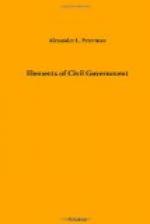In many States primary elections are under the control of the law, and are guarded by the same restrictions that pertain to other elections.
CAUCUSES.—A meeting composed of the members of a legislative body who are of the same party, and assembled for party purposes, is called a caucus. Ward conventions in cities are sometimes called by the same name.
The usual purpose of a caucus is to nominate candidates for offices within the gift of the legislative body, or to consider questions of legislation. A caucus elects a chairman and other officers, but rarely if ever adopts a platform of principles. The great political parties of the country have caucuses in each branch of Congress, and usually in the legislatures of the several States.
SUGGESTIVE QUESTIONS.
1. Name the great parties that have existed in the United States.
2. Who are the respective chairmen of the national executive committees of the two great parties?
3. Read the last national platforms of the two great parties.
4. Which do you like better, primary elections or conventions? Why?
5. Should a member of a legislative body be influenced in his vote by the decision of the caucus of his party?
CHAPTER XXI.
LEGISLATION.
Legislation, the act or process of making laws, is the most important function of government. It is the most important, because it is the first step, and the enforcement and interpretation of laws depend upon their enactment. The laws of a country should be as few in number, as simple in construction, and as uniform in their application, as will meet the needs of the people. It is a great misfortune for the laws to bear unequally upon the people; to grant special privileges to one class, or to impose special hardships upon another class.
The great variety and volume of laws made by the national and the State legislatures of the United States have led to a close study of legislation. In no other country is the process of making laws so thoroughly mastered, or parliamentary law so generally understood.
BILLS.—The process of enacting a law, from its introduction to its final approval, is an intricate and interesting study. Until its passage and final approval, a measure is called either a bill or a resolution.
Bills and resolutions are very similar, the latter usually being simpler, and beginning with the words, “Be it resolved” or simply “Resolved,” while the former begin with the words, “Be it enacted.” A joint resolution as well as a bill requires the concurrence of both houses of a legislative assembly to make it a law.
INTRODUCTION.—The introduction of a bill is the first presentation of it to a legislative body for action. This is usually done by asking “leave” of the body, either orally or in writing, to bring the measure before it. This leave to present is rarely if ever refused.




